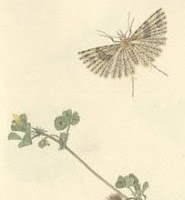
It's taken me a long time to show a caterpillar here. That's because they're hard to find. Moths are bad enough, unless you have a light trap like mine, but caterpillars are experts in the art of hiding. I only saw this one because the geraniums needed watering. Mind you, the great big chunks it had eaten out of the leaves were a clue, and if you really want to find caterpillars, look for similar damage on cabbage-type plants. You will almost certainly discover the cream, green and blue caterpillars of the Large, Small and Green-veined White butterflies. Similarly, earlier in the year - say June or early July - inspecting nettles should turn up colonies of the spiky black caterpillars of the Small Tortoiseshell. A few of these are well worth keeping, if you have children, as they hatch into lovely butterflies. Take care with the nettles (although they, too, are worth gathering for a sort of tastier-than-spinach soup. What does caterpillar mean? Here's the dictionary definition:
"catyrpel" of 1440, derived from French "chatepelose" (?), meaning "hairy cat" (cf. "pile", "pilose", from Latin "pilus" = "hair"; "pill", as in either medicine lozenge or fuzzball, like the hairballs cats regurgitate up, from Latin "pila" = "ball, originally knot of hair"). See also pussy willows and catkins, similar shapes and fuzzinesses associated with the feline. Or from "piller", meaning "pillager/ravager", and "cate", meaning "food" (root of today's "caterer"), as caterpillars devour leaves.
They're in the Bible too, in the famous quote which gave us the phrase 'locust years.' (The Bible is very strong on insects, especially the Book of Deuteronomy): "I will restore to you the years that the locust hath eaten, the cankerworm, and the caterpillar, and the palmerworm, my great army which I send among you." Joel 2:25
 Here's a moth which sounds like a supporting character in a Thomas Hardy novel. The Rosy Rustic. I imagine my ancestors were like this, given the meaning of my surname. Rustics can get a lot rosier than this one, but isn't the patterning fine, even if the palette is like something from Laura Ashley's autumn collection in a year favouring beige? I think I'll add a picture of the other sort of rosy rustic just for comparison.
Here's a moth which sounds like a supporting character in a Thomas Hardy novel. The Rosy Rustic. I imagine my ancestors were like this, given the meaning of my surname. Rustics can get a lot rosier than this one, but isn't the patterning fine, even if the palette is like something from Laura Ashley's autumn collection in a year favouring beige? I think I'll add a picture of the other sort of rosy rustic just for comparison. The other thing that happened yesterday was that I came in from the garden with a friend on the arm of my jumper - see below. I think it may be one of the pesky 'cabbage white' caterpillars I mentioned yesterday, but please put me right if I'm wrong.
The other thing that happened yesterday was that I came in from the garden with a friend on the arm of my jumper - see below. I think it may be one of the pesky 'cabbage white' caterpillars I mentioned yesterday, but please put me right if I'm wrong.















































